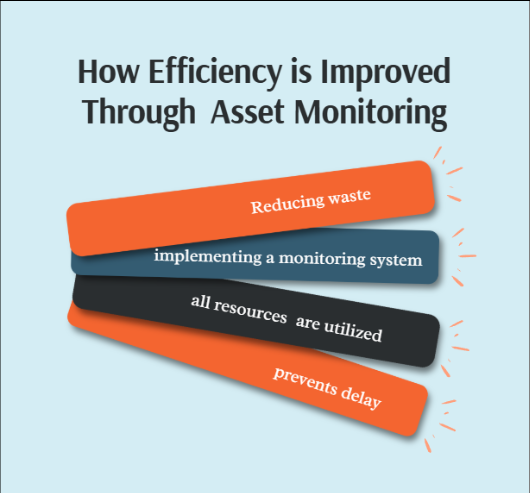Most businesses use equipment, tools, and technology for their operations. But these assets can be hard to manage, particularly when companies have thousands of machines, vehicles, or devices spread across hundreds of locations.
Managing these assets by hand can result in mistakes, delays, and unexpected expenses. That’s why high-end asset-tracking solutions now seem to be trending. They assist companies in monitoring, maintaining, and safeguarding their resources in real time.

Why Asset Monitoring is Important
Millions of companies with assets that include machinery or equipment require an effective way to be the knowledge traded. OT asset management is a system that allows businesses to track and manage their different operational technology assets. This involves tracking equipment locations, usage, and maintenance schedules.
Rather than guess or check every item with a hand-held scanner, companies can use technology to automatically gather real-time information about their assets. This is why asset monitoring, when implemented by businesses, minimizes waste and increases productivity.
Without tracking its machines, a company may not know when something’s broken or needs service. That can result in expensive outages and delays in production. A good monitoring solution can help businesses rectify minor issues before they become major headaches. This enables operations to run smoothly and saves companies money over time.
How Efficiency is Improved Through Asset Monitoring
Perhaps one of the biggest advantages of monitoring the assets is the efficiency. When businesses have a perfect insight into their assets they can make the right decision on how to use them. Alternatively, a vehicle tracking company can monitor its vehicles and come up with the fastest routes that save fuel and time.
If a factory equips its machines with sensors, it can perform timely maintenance instead of waiting for a breakdown. It helps to minimize the downtime as well. If a machine does not function as expected, the whole operation slows down. That will enable them to fix it before it breaks, if companies know when equipment needs maintenance.
This prevents delay and ensures that employees get the work done. Reducing waste is another way asset monitoring increases efficiencies. Improper resource usage makes many businesses unprofitable.
For instance, a business might own expensive equipment but allows anyone with access to it to use it without any oversight, meaning that while some tools may sit idle, others are overworked. By implementing a monitoring system, businesses can ensure that all resources are utilized effectively.

Smart Asset Management to Reduce Costs
Billions of dollars are wasted every year on unused or underused equipment. A major cost-cutting mechanism it implements is avoiding surprise repairs. So when a machine suddenly breaks down, it’s costly to repair. But if a company monitors its equipment, it can detect problems early and do small repairs before they turn into major issues.
Asset monitoring also saves money by stopping theft and loss. Tools and equipment are often misplaced when businesses lack proper tracking systems. Employees can forget things, or someone might take useful equipment. With tracking technology, firms always know the locations of their assets, minimizing the chances of losing them.
Businesses also save money by prolonging the life of their equipment. Machines that are maintained regularly last longer and perform better. When a business knows precisely when to service its equipment, it skips wasteful repairs which allows it to derive maximum utility from its assets.
How to Tailor Your Asset Monitoring to Various Industries
Different asset monitoring needs for different industries. A construction company, for example, may wish to monitor heavy equipment and tools, while a hospital might want to track medical devices and supplies. However, the appropriate solution for monitoring and managing these assets depends on the business type as well as specific problems.
In transportation and logistics, for instance, monitoring helps businesses track vehicles, optimize routes, and make sure deliveries are punctual. In manufacturing, companies use monitoring to ensure machines run smoothly and do not hinder production. Hospitals and clinics use asset monitoring to ensure medical equipment is available and operational, preventing disruptions to patient care.
Retail is another industry that benefits from asset monitoring. By monitoring inventory and shipments, stores can prevent running out of stock and misplacing items. This increases customer satisfaction and allows businesses to run with more efficiency.
Addressing Frequent Hurdles in Performing Asset Monitoring
Though asset monitoring has many advantages, there may be a few challenges a business faces while adopting a new system. One common challenge is cost. The initial costs alone might dissuade some companies from investing in tracking technology. The up-front cost can be substantial, but in the long run, you save much more with even less downtime fewer repairs, and better efficiency.
Employee adoption is another challenge. Some workers may be resistant to learning new technology, especially if they are used to their old ways of manual tracking. To bridge this gap, organizations must train their teams and communicate how asset monitoring streamlines work processes. If employees can see the benefits, they will be more likely to adopt the new system.
This is also a significant consideration of data security. Asset monitoring systems collect sensitive business data, so companies need to ensure access to this data is secure. Secure software and encryption methods make it more difficult for indexes of sensitive information to be accessed by unauthorized individuals.
Asset Monitoring: The Future of Monitoring Assets
In Plato’s cave, against the trees, asset monitoring will continue growing thanks to better technologies. AI and machine learning are also becoming integrated into monitoring systems, enabling businesses to anticipate equipment failures before they occur. This predictive maintenance saves companies money by helping avoid an unexpected breakdown.
Overall, IoT (Internet of Things) is a game changer in asset monitoring. IoT devices link various assets to a central point where you can more easily monitor them. Smart sensors can, for example, know when a machine needs maintenance and schedule a repair automatically.
Monitoring solutions based on the cloud are also gaining popularity. That makes it easier to manage businesses spanning multiple locations, as businesses have access to asset data from anywhere. It enables companies to get instantaneous updates and make decisions on the move.
FAQs
- Why is Asset Monitoring useful to predict an equipment failure?
By monitoring performance data and ensuring that maintenance occurs at the appropriate time, asset monitoring leads to a drop in sudden breakdowns.
- Is the implementation of asset monitoring an expensive solution?
There are some initial expenses, but in the long run, businesses save money on downtime, repairs, and wasting resources.
- Asset Monitoring for Small Businesses: Does it Work?
Yes, asset tracking systems can be tailored to businesses of all sizes and help even small businesses manage their assets well.











